Lumps and bumps
Dr Mike Wyndham
Dr Mike Wyndham is a GP in a suburban practice in Edgware Middlesex He has always been a keen photographer, and has been taking medical photographs for more than 25 years. He has been a regular contributor to the GP press and his work has also appeared in the British Medical Journal, The Pharmaceutical Journal and various medical text books
Sometimes patients may ask you if there is anything that can be done about a lump or bump which they have noticed but which is not causing them any pain or discomfort; sometimes they may want treatment because the lesion is painful, or disfiguring - but sometime you may discover a lump incidentally during the course of an examination or procedure: the important thing is to be alert for those lumps or bumps which may have more sinister connotations, and to refer these patients promptly
GANGLION
Ganglions most commonly develop in the region of the wrist and hand. The foot may also be affected. Younger age groups are most commonly affected with women more commonly suffering with the problem than men. They are benign tumours and when examined are firm and usually well circumscribed. They may vary in size from one to several centimetres. The two main reasons for presentation are a fear that it may be cancer or that it is simply unsightly. Traditionally, a recommended treatment was to hit it with The Bible. However, my problem when advising this, is not really knowing how hard it should be struck! Surgery is an alternative but there is a significant recurrence rate.
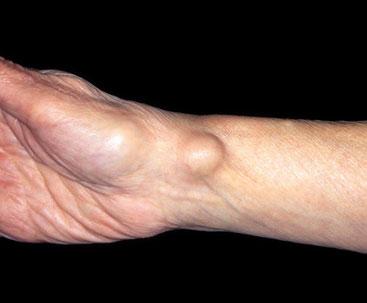
RHINOPHYMA
Rosacea (formerly called acne rosacea) may cause skin flushing, dilated skin blood vessels and redness of the skin. Papules and pustules may form on the cheeks, chin and forehead. The nose may take on a rather bulbous appearance and enlarge and is called a rhinophyma. This can be a source of intense embarrassment. In general terms the skin problem may be treated with topical metronidazole or oral tetracycline. Rhinophyma may be treated by carbon dioxide laser.
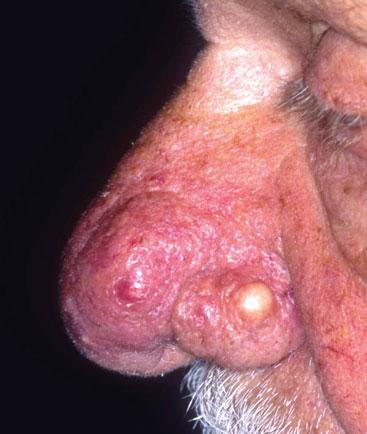
TOPHACEOUS GOUT
Gout arises from the development of uric acid crystals in joints or soft tissues. Many people have a raised blood uric acid but they do not develop gout. The use of loop diuretics such as furosemide predisposes to the condition. Men are more commonly affected than women and Asian people are predisposed to the problem. In chronic tophaceous gout, crystals are deposited in the soft tissues of the hand, wrist and elbow. As shown, it may affect elsewhere. The acute inflammatory nature of gout is demonstrated by redness and swelling. However, in tophaceous gout, there may be a chalky appearance of material under the skin surface or discharging material.
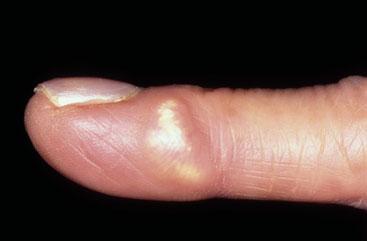
SQUAMOUS CELL CARCINOMA (SKIN)
Beware the newly developed fleshy lesion on the skin of an elderly man. If it is in a sun-exposed area it is likely to be malignant in nature. In this particular case, the differential lies between a squamous cell carcinoma and an amelanotic melanoma. The diagnosis of pyogenic granuloma should not be made in an elderly person without tissue confirmation. This lesion should be removed by a dermatologist. It should be remembered that if a malignant skin lesion is identified it is important to carry out a skin survey to exclude any other malignant lesions.
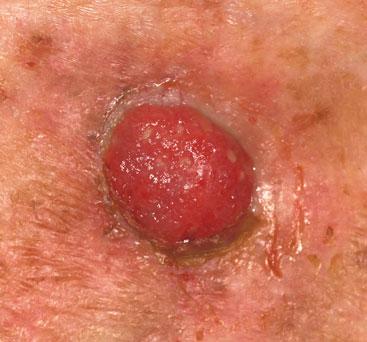
MIXED PAROTID TUMOUR
Salivary gland tumours are fairly uncommon and the parotid gland is the most commonly affected. Around 70-80% of parotid growths will be benign. The growth is usually pain free which helps to distinguish it from an infection where the gland will become tender and swollen. The facial nerve is close to the gland and is much more likely to be affected by a malignant tumour. Fine needle aspiration can be helpful in diagnosing the nature of the problem. The swelling is often unsightly and patients opt for removal by superficial parotidectomy, preserving the facial nerve.
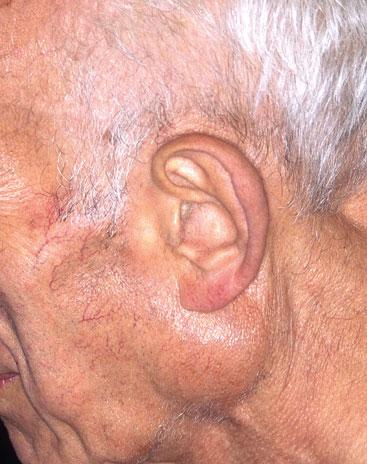
Related articles
View all Articles